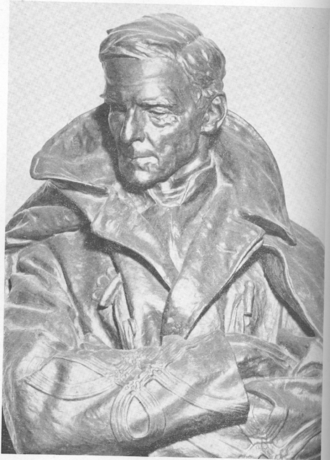Bust of Richard Owen facts for kids
Quick facts for kids Colonel Richard Owen |
|
|---|---|
 |
|
| Artist | Belle Kinney Scholz |
| Year | 1913 |
| Type | Bronze on limestone base |
| Dimensions | 180 cm × 100 cm (70 in × 40 in) |
| Location | Indiana Statehouse, Indianapolis, IN |
| Owner | State of Indiana |
The Colonel Richard Owen bust is a public artwork by American artist Belle Kinney Scholz. You can find it in the Indiana Statehouse in Indianapolis, Indiana. This bronze statue was officially presented in 1913. It honors Colonel Richard Owen of the U.S. Army.
People and groups of Confederate veterans helped pay for the bust. They wanted to thank Owen for his kindness to Confederate prisoners of war. He was in charge of Camp Morton, a prison camp in Indianapolis, during the American Civil War. The bust, including its base, is about 70 inches (180 cm) tall. It is also about 40 inches (100 cm) wide and 21 inches (53 cm) deep.
What the Colonel Richard Owen Bust Looks Like
This bronze statue sits on a base made of three parts of limestone. The sculpture shows Colonel Owen from his waist up. He is wearing a Union military uniform with a cape-like overcoat.
Owen's arms are folded across his chest. He looks down and to his right side. On the bottom left side of the bust, you can see the artist's name: "Belle Kinney/NY".
The top part of the base has a carved wave design around its edge. The middle part of the base has bronze letters that spell out a special message:
- Colonel Richard Owen
- Commandant
- Camp Morton Prison 1862
- Tribute by Confederate Prisoners
- of War and Their Friends
- for his Courtesy and Kindness.
Below this message, there are thirteen small bronze stars. Each star is about 3/4 inches wide. They are placed in a straight line. On the top left side of the middle base, it says "Belle Kinney, Sc" to show who sculpted it. The bottom part of the base has a row of leaves carved into the stone. In 2006, experts said the statue was in excellent condition.
The Story Behind the Colonel Richard Owen Bust
In February 1862, after a battle at Fort Donelson, Indiana Governor Oliver P. Morton agreed to hold Confederate prisoners of war. These prisoners were sent to Camp Morton in Indianapolis. Governor Morton called Owen's group, the 60th Indiana Volunteers, and others to guard the camp. There were 3,700 prisoners there.
Owen took charge of Camp Morton on February 24, 1862. He stayed in command until May 26, 1862. His group was then moved to Kentucky. Owen left Indianapolis with his group on June 20, 1862. While he was in charge, Owen made new rules for the prisoners. He was known for being fair and kind to them.
Fifty years later, in 1911, S. A. Cunningham wanted to create a memorial for Owen. Cunningham was a long-time editor for Confederate Veteran magazine. He had been a prisoner at Camp Morton when Owen was in charge.
To get permission for the memorial, William W. Spencer, an Indiana House of Representatives member, proposed a plan. The plan allowed former Confederate prisoners to put up a plaque for Colonel Richard Owen. This was to thank him for his kindness. The bill was approved by both parts of the state government.
Cunningham first planned a memorial plaque. He asked for donations in the Confederate Veteran magazine from anyone who had been at Camp Morton under Owen. He received more than $1,100. With this money, he asked Belle Kinney Scholz to create a bronze bust instead of a plaque. Belle Kinney Scholz was a sculptor whose father was a Confederate soldier.
The bust was officially presented at the Indiana Statehouse in June 1913. Both Union and Confederate Civil War veterans attended the event. The sculpture was seen as a symbol of friendship between the North and South.
Two copies of the Owen bust were made in 1933. One is at the Indiana Memorial Union at Indiana University in Bloomington. The other copy is at the Purdue Memorial Union at Purdue University in West Lafayette, Indiana.
About the Artist: Belle Kinney Scholz
The artist, Belle Kinney Scholz, shared her thoughts about creating the Owen bust. She said she wanted to show Owen as a man thinking deeply about the big war. She wanted to show his kind heart feeling the pain the war caused, but also understanding why it was necessary. Kinney Scholz stated that no other work she had done brought her as much joy as the Owen bust.

